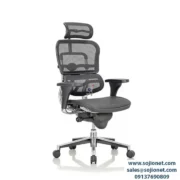Ergonomic Furniture for Home;
Ergonomic furniture is designed to provide maximum comfort and support to the human body. It is essential for people who spend long hours sitting or working at a desk to avoid the risk of developing posture-related health problems. With the rise of remote work and study, ergonomic furniture for the home has become more important than ever. In this product description, we will discuss the benefits of ergonomic furniture for home use and some of the key features to look for when choosing the right furniture.
Benefits of Ergonomic Furniture for Home Use:
- Improved posture: Ergonomic furniture is designed to align the body properly, which helps to maintain good posture. By reducing the strain on the back and neck, ergonomic furniture can prevent the development of posture-related health problems such as back pain, neck pain, and headaches.
- Increased productivity: Ergonomic furniture can help to reduce fatigue and discomfort, allowing people to work for longer periods without getting tired. By providing proper support to the body, ergonomic furniture can increase focus and concentration, leading to increased productivity.
- Better overall health: By reducing the risk of posture-related health problems, ergonomic furniture can contribute to better overall health. Poor posture can lead to long-term health problems such as spinal misalignment, nerve damage, and joint problems. Ergonomic furniture can help to prevent these problems from developing, improving overall health and well-being.
Key Features of Ergonomic Furniture for Home Use:
- Adjustability: One of the most important features of ergonomic furniture is adjustability. Chairs, desks, and other furniture should be adjustable to accommodate people of different sizes and heights. This allows for proper alignment of the body, reducing the risk of posture-related health problems.
- Support: Ergonomic furniture should provide proper support to the body, especially the back and neck. Chairs should have adjustable lumbar support, and desks should be at the right height to allow for proper arm and wrist positioning.
- Comfort: Ergonomic furniture should be comfortable to use for extended periods. This includes soft, supportive cushions, breathable materials, and a design that promotes good circulation.
- Durability: Ergonomic furniture should be built to last, with high-quality materials and construction. This ensures that the furniture can withstand daily use without breaking down or losing its shape.
Some of the most popular types of ergonomic furniture for home use include:
- Ergonomic office chairs: These chairs are designed to provide proper support to the back and neck, with adjustable lumbar support and headrests. They are typically made from breathable materials and are adjustable to accommodate people of different heights and sizes.
- Ergonomic desks: These desks are designed to be adjustable to the proper height to allow for proper arm and wrist positioning. They may also have features such as built-in keyboard trays and adjustable monitor stands.
- Standing desks: Standing desks allow people to work while standing up, which can help to reduce the risk of posture-related health problems. They are typically adjustable to accommodate people of different heights.
- Footrests: Footrests can help to improve circulation and reduce pressure on the lower back and legs. They are typically adjustable to allow for proper positioning.
In conclusion, ergonomic furniture for home use is essential for maintaining good posture, increasing productivity, and improving overall health and well-being. When choosing ergonomic furniture, look for features such as adjustability, proper support, comfort, and durability. With the right ergonomic furniture, you can create a comfortable and healthy workspace at home.








